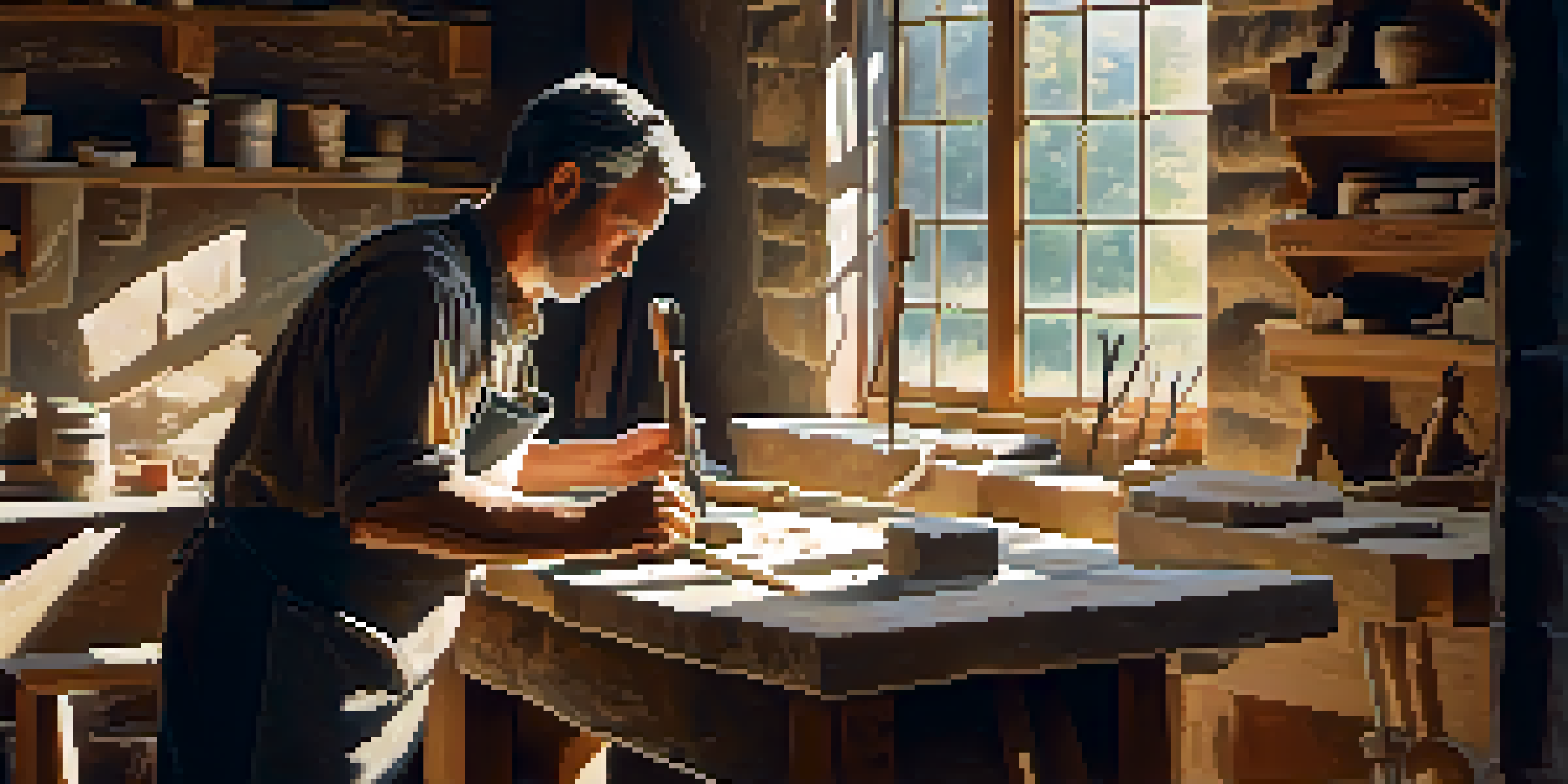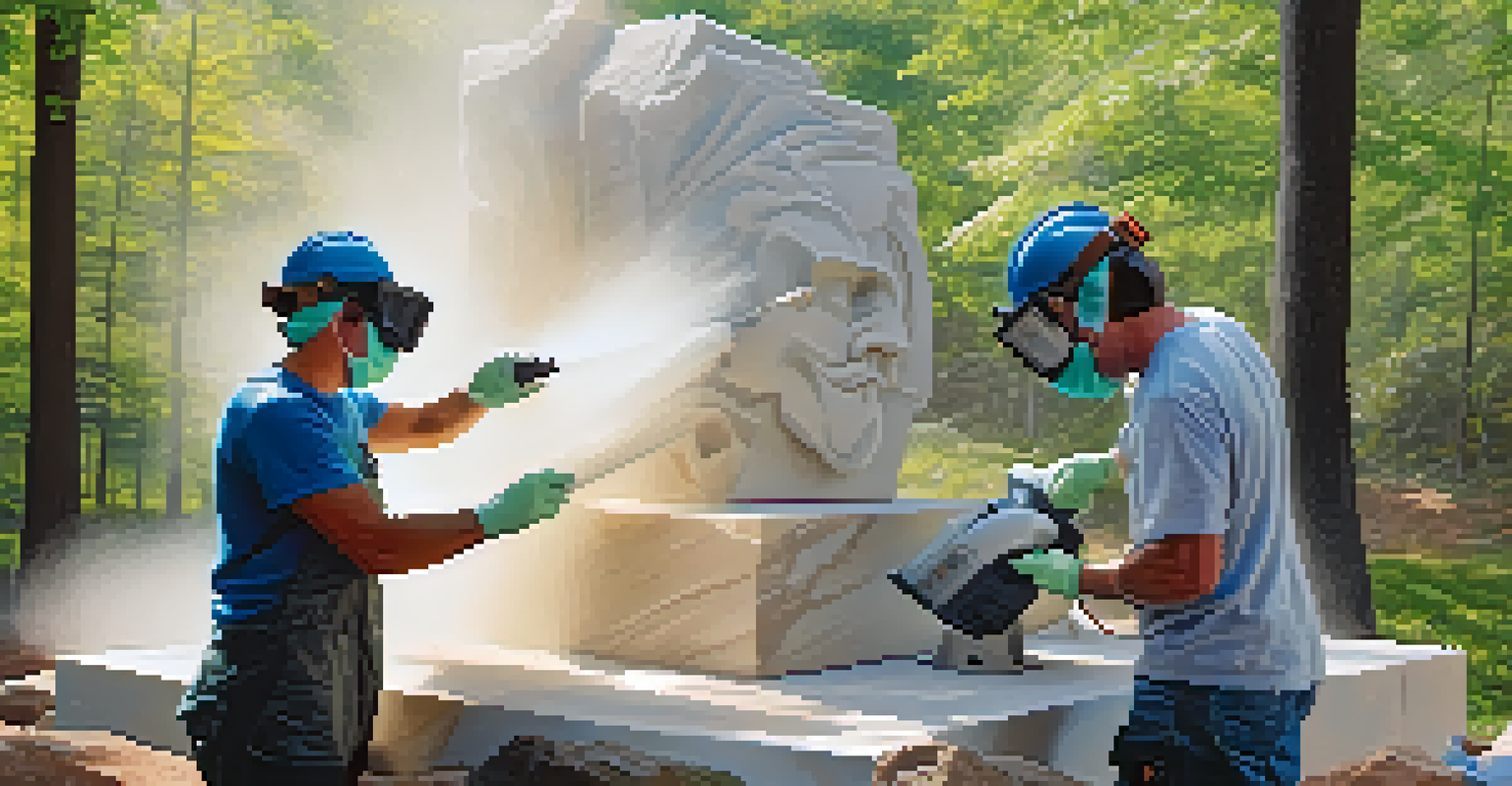Essential Tools for Stone Carving: A Comprehensive Guide

Understanding Stone Carving: An Overview of the Craft
Stone carving is a timeless art form that transforms raw stone into stunning sculptures. This craft requires a blend of creativity and technical skill, often involving a variety of tools to achieve different effects. Whether you're a seasoned artist or a curious beginner, understanding the fundamental tools is crucial for bringing your vision to life.
Every artist dips his brush in his own soul, and paints his own nature into his pictures.
From chisels to hammers, each tool plays a unique role in the carving process. The right tools not only enhance your efficiency but also ensure safety and precision as you work. In this guide, we’ll delve into the essential tools every stone carver should consider, making it easier for you to embark on your stone carving journey.
As we explore each tool, we’ll also look at tips for maintenance and usage, ensuring you get the most out of your equipment. Remember, investing in quality tools can significantly impact your final piece, so let’s get started on transforming those rough stones into beautiful works of art!
Essential Hand Tools: Chisels, Hammers, and More
Hand tools are the backbone of stone carving, with chisels and hammers being the most fundamental. Chisels come in various shapes and sizes, each designed for specific tasks, such as roughing out a form or adding fine details. Pairing the right chisel with a good hammer allows for controlled and precise carving, making your work much more enjoyable.

Additionally, tools like rasps and files are essential for smoothing surfaces and refining shapes. They help in achieving that polished finish that brings your sculpture to life. Investing in a set of quality hand tools can elevate your craftsmanship and provide a satisfying tactile experience as you work with stone.
Essential Tools for Carving
Understanding the various hand and power tools is crucial for both beginners and experienced artists to effectively create stone sculptures.
Remember to choose tools that feel comfortable in your hands, as this can significantly impact your carving technique. Regularly maintaining your hand tools will also ensure they remain effective, allowing you to focus on your creative process without interruptions.
Power Tools: Boosting Efficiency in Stone Carving
Power tools can significantly speed up the stone carving process, especially when working on larger pieces or more intricate designs. Tools like angle grinders and pneumatic chisels allow for rapid material removal, saving you hours of labor. However, it's essential to approach these tools with caution, as they require a different skill set compared to hand tools.
The sculptor will produce the beautiful statue only as a result of a long effort and hard work.
When using power tools, protective gear is a must—goggles, gloves, and ear protection will keep you safe while you work. Additionally, make sure to practice proper technique to avoid damaging your stone or injuring yourself. Start with small projects to build your confidence before tackling larger sculptures.
Incorporating power tools into your toolkit doesn’t mean abandoning hand tools; rather, they complement each other beautifully. By combining the precision of hand tools with the efficiency of power tools, you can create stunning artwork with greater ease.
Safety Gear: Protecting Yourself While Carving
Safety should always be your top priority in stone carving. The process can create flying debris, sharp edges, and dust that can be harmful if proper precautions aren’t taken. Investing in quality safety gear, like goggles, dust masks, and sturdy gloves, is essential to protect yourself from potential hazards.
Additionally, wearing durable clothing and closed-toe shoes can prevent injuries from falls or heavy tools. It’s also wise to work in a well-ventilated area to minimize inhalation of stone dust, which can lead to respiratory issues over time. Remember, taking these precautions not only keeps you safe but also allows you to focus on your artistic expression.
Safety First in Stone Carving
Wearing protective gear and maintaining a safe workspace is essential to prevent injuries while enjoying the stone carving process.
Establish a routine for checking your safety equipment before each session. By prioritizing your safety, you can enjoy the stone carving process without unnecessary worries, letting your creativity shine through.
Maintenance Tools: Keeping Your Equipment in Top Shape
Proper maintenance of your stone carving tools is essential for longevity and performance. Regular cleaning, sharpening, and storage can make a significant difference in how effectively your tools work. For chisels, ensure they are sharp and free of rust to maintain their cutting power.
Consider investing in a quality sharpening stone or file to keep your edges crisp. For power tools, check the blades and attachments frequently, replacing them as needed to ensure optimal performance. A well-maintained tool not only performs better but also enhances your safety while working.
Establish a simple maintenance routine to incorporate into your carving practice. By taking care of your tools, you’ll save time and money in the long run, allowing you to focus on what you love most—creating beautiful stone art.
Choosing the Right Stone: A Guide for Beginners
Selecting the right stone is just as important as having the proper tools. Different types of stone, such as marble, limestone, or soapstone, offer unique textures and levels of hardness that can affect your carving experience. For beginners, softer stones like soapstone are often recommended due to their ease of manipulation and forgiving nature.
As you gain experience, you may want to explore harder stones, which can provide a greater challenge and allow for more intricate details. Knowing the properties of each stone type will help you make informed decisions that suit your skill level and artistic vision. Don’t hesitate to ask other carvers or visit local suppliers for guidance on stone selection.
Choosing the Right Stone Matters
Selecting the appropriate type of stone can greatly influence your carving experience and the intricacy of your artwork.
Ultimately, the right stone can inspire creativity and enhance your carving journey. Take the time to experiment with different stones, and you’ll discover which ones resonate most with your artistic style.
Resources for Stone Carving: Books, Classes, and More
Learning stone carving can be an enriching endeavor, and there are numerous resources available to help you hone your skills. Books on stone carving techniques can provide valuable insights, tips, and inspiration for your projects. Look for titles that focus on both the fundamentals and advanced techniques, catering to your current skill level.
In addition to books, consider enrolling in local classes or workshops. Many communities offer stone carving courses where you can learn from experienced instructors and connect with fellow artists. These hands-on experiences can significantly enhance your understanding of the craft and boost your confidence.

Online resources, such as video tutorials and forums, are also excellent for expanding your knowledge. Engaging with a community of stone carvers can provide support and motivation as you embark on your artistic journey. Remember, the more you learn, the more your skills will flourish.